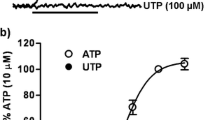Abstract
The present study reinvestigated a series of 5-HT receptor antagonists at both constitutively active rat and human 5-HT7(a) receptors in HEK-293F cells using the cAMP signalling pathway as a functional read-out. Both rat and human 5-HT7(a) receptors were expressed in similar amounts ([3H]-LSD binding: 1.0 to 1.1 pmol/mg protein). Attenuation of basal cAMP formation by the inverse agonist SB-691673 (1 μM) was slightly larger by the human 5-HT7(a) (−73±3 %) than rat 5-HT7(a) receptor (−62±3 %). The 5-HT receptor antagonists investigated here displayed systematically inverse agonism. While methiothepin and SB-269970 displayed similar negative intrinsic activity to SB-691673 at the rat 5-HT7(a) receptor, the compounds SB-258719, mesulergine and metergoline displayed some lower negative intrinsic activity (between −38 and −49%). Inverse agonist properties were observed with potencies fitting with their respective binding pIC50 values and pKB values as estimated from antagonist studies with 5-HT. With the exception of SB-258719 and mesulergine, which remained a partial inverse agonist at the human 5-HT7(a) receptor, the other compounds behaved with a similar Emax value to the full inverse agonist SB-691673. In conclusion, none of the 5-HT receptor antagonists investigated displayed silent properties at the rat or human 5-HT7(a) receptor, when these are expressed in a system allowing detection of constitutive activity. They appear to be partial to full inverse agonists, further illustrating that an antagonist is preferentially an inverse agonist when investigated under constitutively active receptor conditions.



Similar content being viewed by others
Abbreviations
- 8-OH-DPAT:
-
8-hydroxy-2-(di-N-propylamino)-tetralin
- 5-HT:
-
5-hydroxytryptamine
- GPCR:
-
G protein-coupled receptor
- HEK:
-
human embryonic kidney
- LSD:
-
lysergic acid diethylamide
- SB-258719:
-
(R-3,N-dimethyl-N-(1-methyl-3(4-methyl-piperidin-1yl)propyl)benzene sulfonamide
- SB-269970:
-
R-3-(2-(2-(4-methylpiperidin-1-yl)ethyl)-pyrrolidine-1-sulfonyl)-phenol
- SB-691673:
-
2-[2-[4-(5-fluoro-2-oxo-2,3-dihydro-1H-benzimidazol-1-yl)piperidin-1-yl]ethyl]-2,3,4,5-tetrahydro-1H-2-benzazepin-1-one
References
Adham N, Zgombick JM, Bard J, Branchek TA (1998) Functional characterization of the recombinant human 5-hydroxytryptamine7(a) receptor isoform coupled to adenylate cyclase stimulation. J Pharmacol Exp Ther 287:508–514
Bard JA, Zgombick J, Adham N, Vaysse P, Branchek TA, Weinshank RL (1993) Cloning of a novel human serotonin receptor (5-HT7) positively linked to adenylate cyclase. J Biol Chem 268:23422–23426
Furchgott RF (1966) The use of b-haloalkylamines in the differentiation of receptors and in the determination of dissociation constants of receptor-agonist complexes. Adv Drug Res 3:21–35
Gabriel D, Vernier M, Pfeifer MJ, Dasen B, Tenaillon L, Bouhelal R (2003) High throughput screening technologies for direct cyclic AMP measurement. Assay Drug Dev Technol 1:291–303
Guscott M, Bristow LJ, Hadingham K, Rosahl TW, Beer MS, Stanton JA, Bromidge F, Owens AP, Huscroft I, Myers J, Rupniak NM, Patel S, Whiting PJ, Hutson PH, Fone KC, Biello SM, Kulagowski JJ, McAllister G (2005) Genetic knockout and pharmacological blockade studies of the 5-HT7 receptor suggest therapeutic potential in depression. Neuropharmacology 48:492–502
Guthrie CR, Murray AT, Franklin AA, Hamblin MW (2005) Differential agonist-mediated internalization of the human 5-hydroxytryptamine7 receptor isoforms. J Pharmacol Exp Ther 313:1003–1010
Hagan JJ, Price GW, Jeffrey P, Deeks NJ, Stean T, Piper D, Smith MI, Upton N, Medhurst AD, Middlemiss DN, Riley GJ, Lovell PJ, Bromidge SM, Thomas DR (2000) Characterization of SB-269970-A, a selective 5-HT(7) receptor antagonist. Br J Pharmacol 130:539–548
Hedlund PB, Sutcliffe JG (2004) Functional, molecular and pharmacological advances in 5-HT7 receptor research. Trends Pharmacol Sci 25:481–486
Jasper JR, Kosaka A, To ZP, Chang DJ, Eglen RM (1997) Cloning, expression and pharmacology of a truncated splice variant of the human 5-HT7 receptor (h5-HT7b). Br J Pharmacol 122:126–132
Kenakin T (2004) Efficacy as a vector: the relative prevalence and paucity of inverse agonism. Mol Pharmacol 65:2–11
Krobert KA, Levy FO (2002) The human 5-HT7 serotonin receptor splice variants: constitutive activity and inverse agonist effects. Br J Pharmacol 135:1563–1571
Lovell PJ, Bromidge SM, Dabbs S, Duckworth DM, Forbes IT, Jennings AJ, King FD, Middlemiss DN, Rahman SK, Saunders DV, Collin LL, Hagan JJ, Riley GJ, Thomas DR (2000) A novel, potent, and selective 5-HT(7) antagonist: (R)-3-(2-(2-(4-methylpiperidin-1-yl)ethyl)pyrrolidine-1-sulfonyl) phenol (SB-269970). J Med Chem 43:342–345
Mahé C, Loetscher E, Feuerbach D, Muller W, Seiler MP, Schoeffter P (2004) Differential inverse agonist efficacies of SB-258719, SB-258741 and SB-269970 at human recombinant serotonin 5-HT7 receptors. Eur J Pharmacol 495:97–102
Munson PJ, Rodbard D (1980) LIGAND: a versatile, computerized approach for characterization of ligand-binding systems. Anal Biochem 107:220–239
Purohit A, Smith C, Herrick-Davis K, Teitler M (2005) Stable expression of constitutively activated mutant h5HT6 and h5HT7 serotonin receptors: inverse agonist activity of antipsychotic drugs. Psychopharmacology 179:461–469
Ruat M, Traiffort E, Leurs R, Tardivel-Lacombe J, Diaz J, Arrang JM, Schwartz JC (1993) Molecular cloning, characterization, and localization of a high-affinity serotonin receptor (5-HT7) activating cAMP formation. Proc Natl Acad Sci USA 90:8547–8551
Sprouse J, Reynolds L, Li X, Braselton J, Schmidt A (2004) 8-OH-DPAT as a 5-HT7 agonist: phase shifts of the circadian biological clock through increases in cAMP production. Neuropharmacology 46:52–62
Thomas DR, Gittins SA, Collin LL, Middlemiss DN, Riley G, Hagan J, Gloger I, Ellis CE, Forbes IT, Brown AM (1998) Functional characterisation of the human cloned 5-HT7 receptor (long form); antagonist profile of SB-258719. Br J Pharmacol 124:1300–1306
Author information
Authors and Affiliations
Corresponding author
Additional information
In honor of the memory of our dear friend and colleague Dr. Gonzalo Romero (26th of September 1964, Sevilla), who had a great sense of humour and love of life, who died much too soon on the 9th of July 2006.
Rights and permissions
About this article
Cite this article
Romero, G., Pujol, M. & Pauwels, P.J. Reanalysis of constitutively active rat and human 5-HT7(a) receptors in HEK-293F cells demonstrates lack of silent properties for reported neutral antagonists. Naunyn-Schmied Arch Pharmacol 374, 31–39 (2006). https://doi.org/10.1007/s00210-006-0093-y
Received:
Accepted:
Published:
Issue Date:
DOI: https://doi.org/10.1007/s00210-006-0093-y




